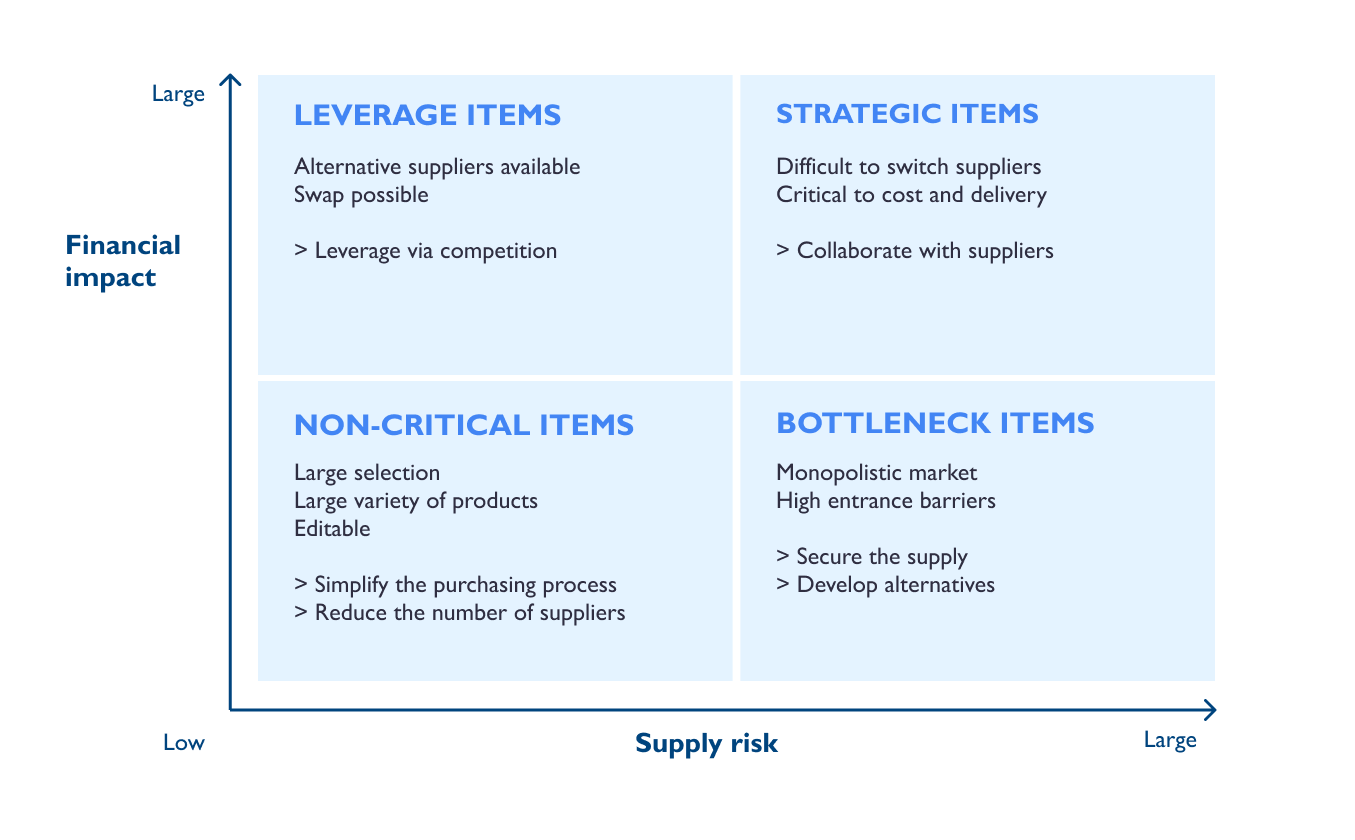Table of contents
Procurement plays a major role in the success of organizations, especially in the technical sector. Managing procurement risks and maintaining strong supplier relationships are essential aspects of effective procurement management.
A valuable tool that organizations can use to address these challenges is the Kraljic matrix. Developed by Peter Kraljic, this model provides insight into the purchasing portfolio and helps determine appropriate purchasing strategies.
In this article, we will explore how the Kraljic matrix can help identify procurement risks and manage supplier relationships.
The importance of procurement risks and supplier relationships
Procurement risks can have significant financial impact on a company. Price increases, unavailability of products and poor supplier service are just a few examples of risks that organizations may face. Therefore, it is vital for organizations to develop the right strategies to minimize these risks while building strong relationships with suppliers.

FREE WHITE PAPER
Reduce Total Cost of Ownership (TCO) with the Kraljic Matrix
The Kraljic matrix: a useful model?
The Kraljic matrix provides a structured framework for analyzing an organization’s procurement portfolio. The model uses two dimensions: supplier risk and impact on the bottom line. By combining these dimensions, procurement categories can be classified into four quadrants: routine products, leveraged products, strategic products and bottleneck products.
Managing Purchasing Categories with the Kraljic Matrix
The matrix acts as a valuable management tool for purchasing categories. It provides a structured approach to analyzing and managing purchasing portfolios. By combining supplier risk and impact on the bottom line, procurement categories can be placed in the right quadrants and the right strategy determined. Using the Kraljic matrix allows a company to prioritize procurement efforts, allocate resources efficiently and build effective supplier relationships.
Attention to alternatives
In the dynamic world of procurement, it is essential to pay attention to alternatives. Having multiple vendors offering similar products or services offers several advantages. First, it minimizes dependence on a single supplier, thereby reducing risk. Second, it encourages competition among suppliers, which can lead to better price trends and service conditions. By paying attention to alternatives and actively seeking new suppliers, a company can maintain flexibility and competitive advantage.
Point of interest in contracts: the importance of good agreements
An important part of effective supplier management is having proper agreements in contracts. Agreements with suppliers must be clear, specific and legally enforceable. They should cover important aspects such as prices, delivery terms, quality standards and responsibilities. By paying attention to contracts and making sure they are solid and comprehensive, a company can reduce potential conflicts and risks. It is also important to review contracts regularly and update them as needed to meet changing needs.

Free whitepaper
Project Procurement in the Machine Building Sector
Analysis of suppliers
A thorough supplier analysis is an essential part of effective supplier management. It allows a company to understand the performance, reliability and financial position of suppliers. Regularly assessing suppliers can identify weaknesses and make improvements. It is also important to keep an eye on the vendor market and stay abreast of new players and trends. In-depth supplier analysis enables a company to make informed decisions and build strong supplier relationships.

Clear functional specifications
One of the most important aspects of procurement is defining the basis of specification. Functional specifications describe the requirements and characteristics of the desired product or service. Having clear and detailed specifications is essential for evaluating and comparing suppliers. It also helps prevent misunderstandings and discrepancies between what a company expects and what a supplier delivers. By paying attention to the basics of specification, a company can ensure that it receives the right products and services that meet required standards and expectations.
How important is having enough suppliers?
Having alternative and sufficient suppliers is critical to minimize risk and ensure a smooth procurement process. By having multiple suppliers, a company can benefit from diversity and competition. It also helps ensure product availability and prevent supply chain interruptions. A company should aim to have enough suppliers in different categories to have many alternatives and reduce vulnerability in purchasing.
Find a buyer through xentys
At xentys, your experienced procurement recruitment agency, we are happy to help you find the right professional for your procurement team. Send a message today and strengthen your purchasing department.
Digital transformation and the impact on procurement
There is no denying the impact of digitalization on procurement strategies. Innovative technologies such as artificial intelligence and blockchain are redefining not only how organizations procure their types of products, but also how they manage costs and maximize profits. With a growing number of vendors offering digital solutions, it is becoming increasingly important for companies to distinguish the low value of traditional methods from the high value that technology can bring. By combining the Kraljic matrix with these new tools, organizations can expect more detailed results. They are able to make real-time decisions, proactively identify risks and optimize their procurement processes. It is essential that in this digital century, organizations embrace both traditional approaches and the latest technologies to achieve the best results in their procurement management.
Conclusion
In a complex and dynamic procurement landscape, as a buyer you are constantly looking for ways to manage risk and build strong supplier relationships. The Kraljic matrix has proven to be your indispensable guide in this process. By looking critically at your suppliers, strengthening your contractual agreements and embracing the latest digital tools, you can proactively address challenges and opportunities in your procurement processes.
In an era when technology and market dynamics are changing at lightning speed, it is important not only to rely on proven methods, but also to be innovative in your approach. With the Kraljic matrix as your compass, you can shape your purchasing strategies for a successful future with confidence and vision.
News

What is the meaning of SKU?
A SKU, or Stock Keeping Unit, is a unique code used to identify a specific product that is in stock. This alphanumeric code is indispensable for inventory management and logistics operations, as it allows products to be tracked and managed. SKUs can contain information about a product’s attributes, such as

What is meant by the 80/20 rule?
The 80/20 rule, also known as the Pareto principle, is an economic rule that states that 80% of all results come from 20% of all efforts. This rule was first introduced by Italian economist Vilfredo Pareto, who discovered that 80% of the land in Italy was owned by only 20%

What does 3PL & 4PL mean?
The terms 3PL (Third-Party Logistics) and 4PL (Fourth-Party Logistics) play an important role in supply chain management today. But what exactly do those terms mean? 3PL refers to a logistics service provider that outsources specific logistics functions, such as transportation, warehousing and distribution, to an external party. These service providers

What is a freight forwarder?
A freight forwarder, also known as a forwarding agent, is an essential link in the logistics chain. This party organizes and coordinates the transportation of goods from one location to another. In this context, the necessary means of transportation, such as trucks, ships or aircraft, must be arranged and





